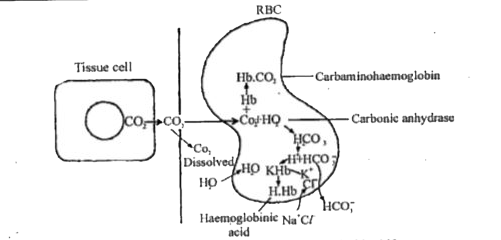Describe the method of transport of CO2 in human body.
Text Solution
Transport of carbon dioxide: CO2 is produced in tissues by cell respiration. It is carried by blood in three forms:
i) Dissolved CO2 or Physical solution: About 7% of carbon dioxide dissolves in plasma and is carried as a physical solution.
ii) Bicarbonate ions : Maximum amount of carbondioxide diffuses from the plasma into red blood corpuscles. About 70% of CO2 enters the RBCs. It combines with water to form carbonic acid. The reaction is catalysed by carbonic anhydrase.
Co2+H2Ocarbonic⇐===⇒anhydraseH2CO3
H2CO3⇔H++HCO−3
Carbonic acid dissociates into bicarbonate and hydrogen ion. Hydrogen ion is picked up by proteins and bicarbonate ions are joined by bases to maintain pH of the blood. A small amount of bicarbonate ions is transported in RBC, while most of them diffuse into plasma. The exit of bicarbonate ions changes ionic balance between plasma and erythrocytes. To restore the ionic balance, the chloride ions diffuse from the plasma into erythrocytes. This movement of chloride ions is known as chloride shift or Hamburger.s phenomenon.
iii) Carbaminohaemoglobin: About 23% of carbondioxide enters RBCs. It combines with amino groups of globin part of haemoglobin. This type of combination also occurs with other proteins present in the plasma.
RNH2+CO2⇔RNHCOOH
Amino group⇔Carbamino compound
Hb+CO2⇔HbCO2 (Carbaminohaemoglobin)
Formation of carbamino bond in haemoglobin does not reduce its oxygen carrying capacity because O2 combines with haeme group while CO2 attaches to amino group of globin. About 3.7 cc of CO2 passes into 100 cc of blood in tissues. The same amount is released in lungs. It combines with HCO−3 ions to form carbonic acid. Carbonic acid dissociates to form CO2 and H2O .

|
Updated on:21/07/2023
Similar Questions
Knowledge Check
- Question 1 - Select One
the enzyme essential for the transport for the transport of CO2 as dicarbonate in blood is
ACarboxypeptidaseBSuccininc dehydrogensaseCCarbonic anhydraseDThombokinase
Describe various methods of birth control in human being
View SolutionName two liquids which help in the transport of substances in the human body.
View SolutionName a protein which is involved in the transport of oxygen inside the human body.
View Solution(a) Name the organs that form the excretory system in human beings.
(b) Describe in brief how urine is produced in human body.View SolutionDescribe briefly the method to determine the density of an irregular body.
View SolutionState the different modes of CO2 transport in blood.
View SolutionState the different modes of CO2 transport in blood.
View Solution

